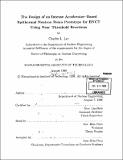The design of an intense accelerator-based epithermal neutron beam prototype for BNCT using near-threshold reactions
Author(s)
Lee, Charles L. (Charles Leon), 1970-
DownloadFull printable version (9.706Mb)
Alternative title
Design of an intense accelerator-based epithermal neutron beam prototype for boron neutron capture therapy using near-threshold reactions
Advisor
Xiao-Lin Zhou.
Terms of use
Metadata
Show full item recordAbstract
Near-threshold boron neutron capture therapy (BNCT) uses proton energies only tens of keV above the (p,n) reaction threshold in lithium in order to reduce the moderation requirements of the neutron source. The goals of this research were to prove the feasibility of this near-threshold concept for BNCT applications, using both calculation and experiment, and design a compact neutron source prototype from these results. This required a multidisciplinary development of methods for calculation of neutron yields, head phantom dosimetry, and accelerator target heat removal. First, a method was developed to accurately calculate thick target neutron yields for both near-threshold and higher energy proton beams, in lithium metal as well as lithium compounds. After these yields were experimentally verified, they were used as neutron sources for Monte Carlo (MCNP) simulations of neutron and photon transport in head phantoms. The theoretical and experimental determination of heat removal from a target backing with multiple fins, as well as numerical calculations of heat deposition profiles based on proton energy loss in target and backing materials, demonstrated that lithium integrity can be maintained for proton beam currents up to 2.5 mA. The final design uses a proton beam energy of 1.95 MeV and has a centerline epithermal neutron flux of 2.2 x 108 n/cm2-sec/mA, an advantage depth of 5.7 cm, an advantage ratio of 4.3, and an advantage depth dose rate of 6.7 RBE-cGy/min/mA, corresponding to an irradiation time of 38 minutes with a 5 mA beam. Moderator, reflector, and shielding weigh substantially less than other accelerator BNCT designs based on higher proton energies, e.g. 2.5 MeV. The near-threshold concept is useful as a portable neutron source for hospital settings, with applications ranging from glioblastomas to melanomas and synovectomy.
Description
Thesis (Ph.D.)--Massachusetts Institute of Technology, Dept. of Nuclear Engineering, 1998. Includes bibliographical references (p. 209-219).
Date issued
1998Department
Massachusetts Institute of Technology. Department of Nuclear Science and EngineeringPublisher
Massachusetts Institute of Technology
Keywords
Nuclear Engineering